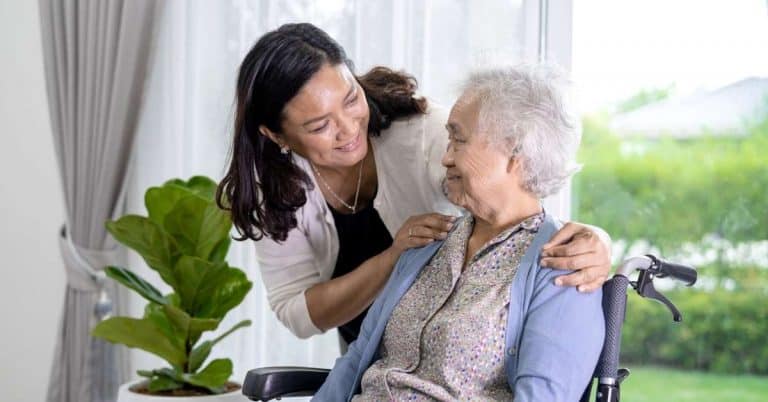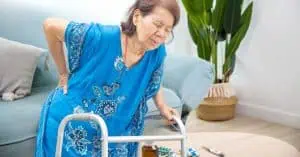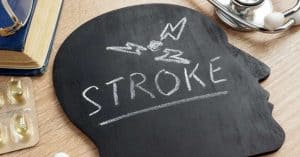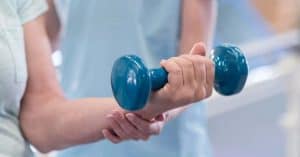In stroke treatment, every minute counts. The "golden hours" – typically the first 4.5 hours after stroke symptoms start – can mean the difference between full recovery and permanent disability. But what follows is equally critical: the first six months post-stroke, known as the subacute stage. Just as the golden hours are pivotal for immediate intervention, these months are the golden window for recovery and rehabilitation.
In this article, we'll explore why this subacute stage is the cornerstone of a stroke patient's journey back to health, especially for those recovering at home. Read on to learn about effective rehabilitation techniques, the role of technology in stroke recovery, and how caregivers and loved ones can help stroke survivors overcome the challenges in regaining their pre-stroke capabilities after hospital discharge.
Table of Contents
Understanding Stroke Recovery Stages
Stroke recovery can be broadly divided into three stages:
- Acute stage: This initial stage occurs immediately after the stroke and lasts for a few days. This is a critical time where quick medical intervention is key to minimise brain damage.
- Subacute stage: Spanning from a few days to 6 months post-stroke, this stage focuses on targeted therapy to help survivors regain lost skills and functions.
- Chronic stage: Starting around 6 months after the stroke, this phase involves long-term management and adaptation to the lasting effects of stroke recovery.
The Acute Stage of Stroke
The acute stage often occurs in hospitals and typically lasts a few days to a week. During this critical period, healthcare professionals administer treatment depending on the type, location, and severity of the stroke, as well as the patient's overall health.
For ischemic strokes, clot-removing techniques are sometimes used, while hemorrhagic strokes may require surgery to control bleeding and reduce brain pressure. The goals during this time are:
- Saving lives
- Preserving brain tissue
- Managing symptoms
- Preventing further complications.
As the acute stage concludes and the immediate threat stabilises, initial rehabilitation efforts may begin and the patient transitions to the subacute phase.
The Subacute Stage of Stroke
The subacute stage begins when a patient is cleared to start structured and focused rehabilitation, typically lasting up to six months post-stroke. This stage is crucial for stroke recovery, as during this period, the brain has heightened capabilities to reorganise, adapt and form new connections through activities and targeted therapies. Known as brain plasticity or neuroplasticity, this capability allows for more effective rehabilitation interventions and rapid functional improvements.
This period is also pivotal for preventing complications and recurrent strokes, adapting treatment plans, and setting the foundation for long-term recovery outcomes.
During the subacute phase, stroke survivors often undergo comprehensive rehabilitation that extends beyond the hospital. Depending on the post-stroke effects they experience, stroke patients may benefit from a physiotherapist, speech-language pathologist, an occupational therapist, or a rehabilitation physician in complex cases, to address key aspects such as:
- Intensive rehabilitation to relearn skills and improve function
- Regular monitoring to prevent recurrent strokes and secondary complications
- Adjusting rehabilitation plan based on progress
- Supporting patients and families through the emotional challenges of recovery.
In addition to therapy, it is recommended to follow up regularly with your doctor to address new or recurring symptoms promptly, adjust medications as needed, and monitor overall health, especially for people with other existing conditions.
The Chronic Stage of Stroke
The chronic stage typically begins about 6 months after the stroke and can last for years. While the rapid improvements of the subacute stage may slow down, ongoing rehabilitation efforts and monitoring remain important to make further gains or maintain the progress you have achieved. As stroke recovery requires long-term management and continuous effort, it is classified as one of the 23 chronic conditions under Singapore’s Chronic Disease Management Program (CDMP).
Management during this stage focuses on:
- Maintaining and refining improvements achieved earlier
- Adapting to any residual disabilities
- Enhancing quality of life and independence
- Managing long-term health issues and preventing recurrent strokes.
For the remainder of this article, we will dive deeper into the subacute phase, exploring the essential techniques, helpful aids, and the common challenges that stroke survivors often encounter during this critical stage of recovery.
Stroke Rehabilitation Techniques during Subacute Phase
A stroke can affect various aspects of life, from physical abilities to cognitive functions. Stroke survivors might experience a range of challenges such as muscle weakness, difficulty speaking or swallowing, memory issues, or mental health challenges. The subacute phase is a crucial period for intensified therapies to address these effects of stroke, thanks to the brain's increased plasticity.
During this phase, you will work with the rehabilitation team to come up with a personalised rehabilitation program addressing your specific needs. This may include:
- Physical therapy to improve mobility, balance and coordination
- Speech therapy to enhance communication and swallowing
- Cognitive therapy to boost memory and thinking skills
- Behavioural therapy for emotional support
- Additional exercises like brain games, swimming or other activities you can safely perform by yourself.
The rehabilitation journey may begin in the hospital and continue at home or in a long-term care facility. While your doctors and therapists are there to guide and support you, it is important to actively communicate your experiences, challenges, and goals to your healthcare team. As every stroke survivor's journey is different, such understanding will help your doctor and therapists tailor the intensity and types of therapies to your specific needs. This collaboration ensures you receive the most effective care and make the most of this critical subacute phase.
Physical Therapy (PT) for Stroke Patients
Physical therapy, or physiotherapy, plays a central role in subacute rehabilitation for stroke patients experiencing physical symptoms. The goal is to improve motor skills, balance, and coordination, addressing symptoms such as weakness, muscle stiffness, balance and coordination issues, endurance and pain.
Physical therapists begin by assessing your level of motor dysfunction and mobility limitations. Therapy sessions often include targeted exercises designed to meet specific physical therapy goals. Depending on your needs, you may work directly with a physiotherapist or use equipment available at the care facility under the therapist’s supervision.
As you transition to home care, your physiotherapist may recommend safe and effective home-use equipment, such as resistance bands, ankle and wrist weights, or portable treadmills and stationary bicycles. These tools help ensure continued physical improvement and maintenance of the progress made during in-facility rehabilitation.
Speech and Language Therapy for Stroke Patients
Speech and language therapy addresses communication challenges and swallowing difficulties which often arise after a stroke. The therapist who works on speech and swallowing issues is called a Speech-Language Pathologist (SLP). They are trained to evaluate, diagnose, and treat disorders related to speech, language, communication, and swallowing.
The speech and language specialist will work with you to restore as much speech and language function as possible. They may instruct you to do tongue exercises or practise swallowing techniques to strengthen the muscles involved in speaking and swallowing. They may also use techniques and aids such as picture boards or electronic speech devices.
For stroke survivors with mild speech and swallowing issues, treatment can often be effectively managed at home. However, more severe cases may require intensive therapy at a hospital or clinic, followed by continued treatment at home through teletherapy or face-to-face sessions to maintain and build upon the progress made in clinical settings.
Enhancing Recovery with Technology and Aids in Stroke Rehabilitation
Thanks to advances in medical research, stroke rehabilitation techniques have significantly evolved, offering stroke survivors more opportunities for long-term functional improvements. One example is Functional Electrical Stimulation (FES), which uses electrical impulses to stimulate muscle contractions in the affected limbs. FES has been shown to be effective in improving hand function and gait, especially in elderly stroke patients. Virtual reality (VR) systems also offer immersive environments for practising daily activities safely, making therapy more engaging and effective for patients.
You can discuss the availability and suitability of these technologies with your doctors and therapists. Support groups such as groups run by Singapore National Stroke Association or Stroke Support Station (S3) can also share valuable insights and experiences. In addition to advanced technologies, traditional tools can greatly enhance daily living. Examples include:
- Adaptive utensils and tools for everyday tasks
- Balance aids like walking sticks or wheel walker
- Orthotic devices to support weakened limbs
These technological solutions and aids not only enhance the effectiveness of your therapy but also empower you to take an active role in your stroke recovery journey, even after you have been discharged from the hospital or care facility. Ask your doctor or therapist what is suitable and available for your case.
Home Modifications for a Safe Recovery
As you transition from clinical settings to home-based care, it is important to make sure your living space is adapted to support your recovery and ensure your safety. Home modifications help you maximise independence and continue the progress made during therapy sessions at hospital or clinics.
Specific modifications depend on your home layout, but here are the common considerations:
- Install grab bars in the bathroom
- Apply slip-resistant treatment to bathroom floor
- Widen bathroom entrance for wheelchair accessibility
- Remove trip hazards like loose rugs, cables or clutter
- Rearrange furniture to create wider pathways to move around
- Install shower seat or shower chair in the bathroom
- Install ramps or wheelchair lifter at the entrance
Make sure your post-stroke recovery at home is best facilitated by making safety a priority once you return home. You can get up to 95% subsidies for the approved home modification items under HDB’s EASE scheme. Check out eligibility criteria for EASE program here and list of subsidised items and subsidy amounts here.
Stroke Recovery Challenges in the Subacute Stage
Stroke recovery can be hampered by non-medical factors, such as the tendency to compensate by the stroke patient, or the overprotection offered by the family. In the following sections, we will discuss the common challenges stroke patients and their loved ones need to be aware of during recovery, and how to overcome them for the best possible outcome.
Personalised Rehabilitation: The Key to Progress
In stroke recovery, generic rehabilitation programs often fail to address your specific needs, leading to slower or less effective progress. To ensure you achieve a steady recovery, it is crucial to work closely with specialists to develop a plan tailored to your unique challenges. Make sure the healthcare team understands your struggles and goals and is updated with new symptoms and changes promptly.
By playing an active part in the rehabilitation journey, you enable your healthcare team to fine-tune your treatment plan and maximise your recovery potential.
Navigating the Emotional Rollercoaster
Relearning essential skills after a stroke can be frustrating, and the recovery process often feels like an uphill battle. Research shows that post-stroke depression affects up to 1 in 3 stroke survivors. Even the most resilient stroke survivors experience low days and struggle with motivation.
Understanding that these emotional challenges are common and that you are not alone can help you prevent them from overwhelming you and potentially hindering your engagement in rehabilitation. On days when progress feels slow or nonexistent, lean on your support system to help you through. If you are a caregiver or family member, be mindful of your loved one’s emotional state. Remind them of the victories they achieved the day before and offer a listening ear to help them through the tough times.
Avoiding Premature Adaptation
Premature compensation in stroke recovery occurs when patients rely on their unaffected limbs or alternative strategies to perform tasks instead of using the affected limbs. While this may seem helpful in the short term, it can actually hinder long-term recovery by preventing the affected limbs from being fully engaged in rehabilitation, thus limiting neuroplasticity and the potential for regaining lost functions.
To avoid this, make sure to stay patient and persistent with your prescribed exercises, even when progress seems slow. Talk to your doctor or therapist if you feel that you are not actively using both the affected and unaffected limbs in the recovery process.
Finding the Right Balance of Support
Well-meaning family members and caregivers might unintentionally slow your progress by offering too much help. While their support is invaluable, finding the right balance is key. As a family member, be there for emotional support without taking over tasks your loved one needs to practise. If you are the one affected by the stroke, remind your loved ones that you are committed to regaining independence and will seek their assistance when it is truly necessary. This approach ensures that you can fully engage in your rehabilitation while getting just the right amount of support you need.
Takeaway Message
For many stroke survivors and their families, a stroke is a life changing event. Effectively navigating and managing the subacute stage of stroke recovery is essential to unlocking the full potential of rehabilitation and lessening the impact of stroke. Take advantage of this period, as the brain’s heightened plasticity offers a unique window of opportunity for significant recovery through targeted interventions.
As a home care provider, Ninkatec is dedicated to be your companion in your stroke recovery journey, ensuring they recuperate safely and effectively at home. Our experienced doctors and therapists are well-versed in addressing the complexities of subacute symptoms after stroke to enhance the rehabilitation process.
Reach out to us to learn more about our post-stroke care services, and let’s work together to make every step forward count!









